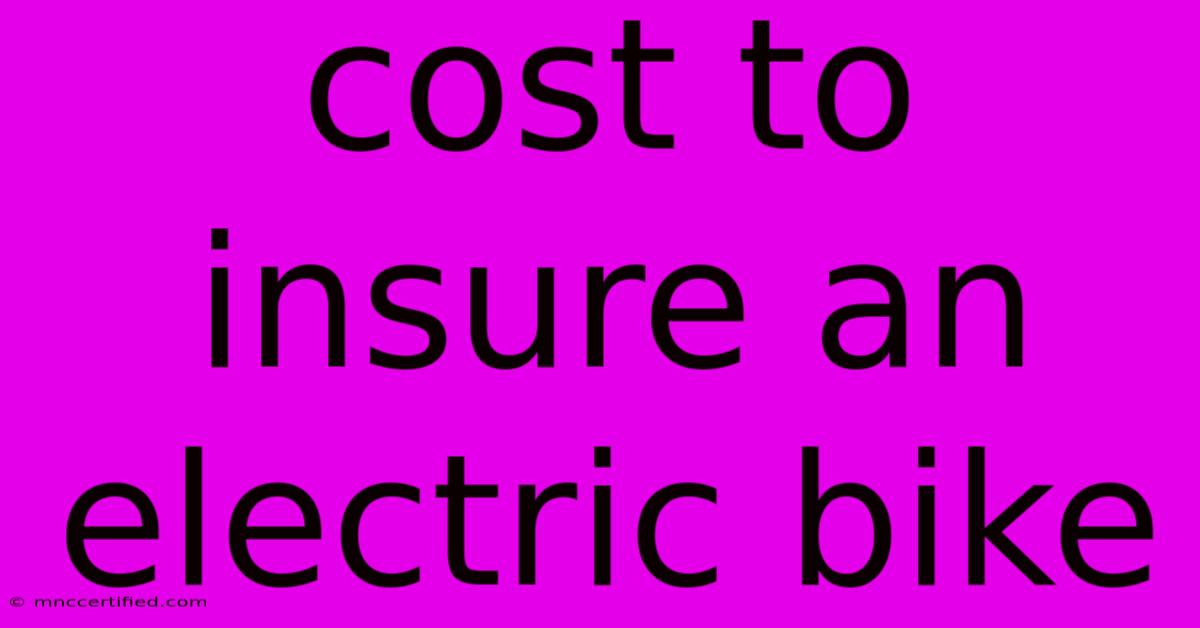Cost To Insure An Electric Bike

Table of Contents
The Cost to Insure an Electric Bike: A Comprehensive Guide
Electric bikes (e-bikes) are gaining popularity, offering a blend of eco-friendliness and convenience. But before you hop on your new e-bike, understanding the cost to insure it is crucial. This comprehensive guide breaks down the factors influencing e-bike insurance premiums and helps you find the best coverage for your needs.
Factors Affecting E-Bike Insurance Costs
Several factors determine how much you'll pay for e-bike insurance. These include:
-
E-bike Value: The more expensive your e-bike, the higher your premium will likely be. Insurers assess risk based on the potential payout in case of theft or damage. High-end e-bikes with advanced features command higher insurance costs.
-
Your Location: Areas with higher rates of e-bike theft or accidents will generally have higher insurance premiums. Urban areas, for example, often have higher rates than rural areas.
-
Your Coverage Level: The extent of your coverage directly impacts your premium. Basic liability coverage will be cheaper than comprehensive coverage, which includes theft, damage, and potentially even third-party liability. Consider what level of protection best suits your needs and budget.
-
Your Riding Habits: Do you primarily ride on paved roads or off-road trails? Off-road riding generally carries a higher risk and could lead to increased insurance premiums. Your insurer might ask about your typical riding distance and frequency.
-
Your Age and Riding Experience: Like car insurance, your age and riding experience might influence your premium. Younger riders with less experience might face higher premiums due to perceived higher risk.
-
Insurer: Different insurers have different pricing structures and risk assessments. Shopping around and comparing quotes from multiple insurers is essential to finding the best deal. Don't settle for the first quote you receive; compare several options.
-
Add-ons: Some insurers offer add-ons like roadside assistance or accessory coverage. These add-ons will increase your premium but can provide valuable peace of mind. Consider if these extras are worth the added cost for your specific circumstances.
-
Type of E-Bike: The type of e-bike (Class 1, 2, or 3) might influence the cost. Class 3 e-bikes, which can reach higher speeds, might be considered riskier and therefore cost more to insure.
Types of E-Bike Insurance Coverage
Understanding the different types of coverage is crucial to making an informed decision:
-
Liability Coverage: This covers damages or injuries you cause to others while riding your e-bike. It's the minimum coverage required in many areas, but it doesn't protect your e-bike itself.
-
Comprehensive Coverage: This covers damages to your e-bike due to accidents, theft, vandalism, and other unforeseen events. It provides the most comprehensive protection but comes with a higher premium.
-
Collision Coverage: This covers damages to your e-bike if it's involved in a collision with another vehicle or object.
-
Theft Coverage: This covers the replacement cost of your e-bike if it's stolen.
-
Accidental Damage Coverage: This covers damage to your e-bike resulting from accidents, even if you're not at fault.
Finding the Right E-Bike Insurance
To find the best e-bike insurance for your needs, follow these steps:
-
Assess your needs: Determine the level of coverage you require based on your e-bike's value, riding habits, and location.
-
Compare quotes: Obtain quotes from multiple insurers. Use online comparison tools or contact insurers directly.
-
Read the policy carefully: Before committing to a policy, understand the terms, conditions, and exclusions.
-
Consider add-ons: Evaluate whether additional coverage options, such as roadside assistance or accessory coverage, are worthwhile for your needs.
-
Regularly review your policy: As your needs or the value of your e-bike change, review your policy and make adjustments as necessary.
Cost Estimates and Alternatives
While providing exact cost estimates is impossible without specific details, you can expect to pay anywhere from $50 to $300+ annually for e-bike insurance. The cost varies significantly based on the factors discussed above.
Some homeowners or renters insurance policies might offer limited coverage for e-bikes, but it's essential to check your policy carefully. Consider contacting your insurer to inquire about potential coverage. Remember, underinsurance is a significant risk, so carefully weigh the cost versus the potential financial burden of an uninsured incident.
By carefully considering these factors and comparing options, you can find the right e-bike insurance coverage at a price that fits your budget and provides you with the protection you need. Remember, protecting your investment is key to enjoying the ride!

Thank you for visiting our website wich cover about Cost To Insure An Electric Bike. We hope the information provided has been useful to you. Feel free to contact us if you have any questions or need further assistance. See you next time and dont miss to bookmark.
Featured Posts
-
Worst Rated Insurance Companies
Nov 26, 2024
-
Sonic 3 Trailer Drops Keanu Reeves
Nov 26, 2024
-
Glasgow Stadium Lana Del Rey Live
Nov 26, 2024
-
West Ham Areola Starts Against Newcastle
Nov 26, 2024
-
Ronaldos Two Goals Power Al Nassr
Nov 26, 2024